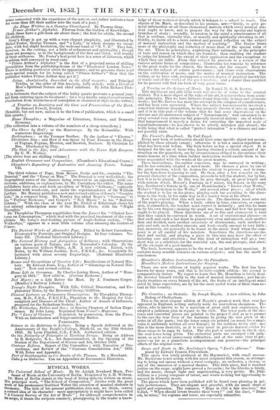The Pianist's Handbook. By Carl Engel. Every new book of
instruction should have some specific object not accom- plished by those already extant ; otherwise it is but a useless repetition of what has been said before. The book before us has a special object. It is designed for the use of those who, having obtained a certain amount of in- struction on the pianoforte, are by circumstances obliged to discontinue their music-lessons at a time when further instruction would enable them to be- come acquainted with the works of the great masters.
These instructions, the author conceives, may be conveyed in writing; and he has certainly adopted a novel mode. He chooses a piece by one of the great masters, which he desires the student to procure, and to num- ber the bars from beginning to end. He then, after a few remarks on the general character of the composition, proceeds to tell the student, bar by bar, how it is to be played. In this way he goes through, at great length and with minute detail, Mozart's Fantasia in C minor, his Sonata in the same key, Beethoven's Sonata in Gs one of Mendelssohn's " Lieder ohne Worte," Weber's "Invitation to the Waltz," and several other pieces ; all of which the student is to lay on his piano, playing each bar according to the direc- tions in the book, in the same way as if a master were at his elbow. Now it is evident that this will never do. The directions must arise out of the pupil's playing. When a fault, either in time, execution, or expres- sion is committed, the teacher must correct it instantly; and this he must do by hieown fingers—making the pupil see, hear, and feel how the passage ought to be played. These directions are of so fine and evanescent a kind that they cannot be conveyed in words. A set of conventional phrases—as that such and such a bar must be played very even and smooth, such another firm and decided, such another crescendo or diminuendo, such another le- gato and soft, such another staccato and loud—really amount to very little ; and, moreover, are generally to be found in the music itself when the com- poser is at all careful of his notation. Sometimes the directions are dis- tinct and useful, and playing a piece in this way may have the effect of inducing care and attention ; but this kind of instruction will go a very short way as a substitute for the watchful eye, the oral precepts, and above all the example of a good master. The book, however, appears to he the work of an intelligent musician. It contains many sensible remarks on various subjects; and has the merit of conciseness.
Hamilton's Modern Instructions for the Pianoforte. Hamilton's Modern Instructions for Singing.
These are new editions of highly popular works. The first has been known for many years, and this is its forty-eighth edition : the second is comparatively recent. We regret to learn that Mr. Hamilton is lately dead. He devoted himself wholly to the task of musioal instruction; • and his di- dactic treatises on every branch of the art, the fruits of an intelligent mind aided by large experience, are by far the most useful works of their class ex- tant in this country.


































 Previous page
Previous page